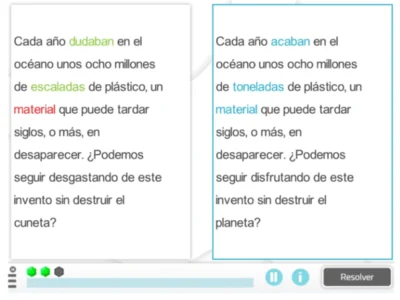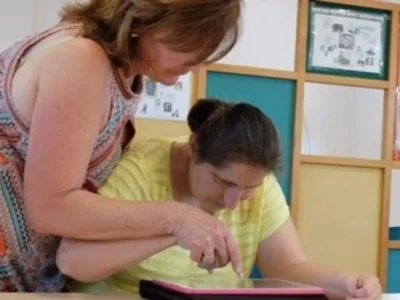Neuropsychologist and psychotherapist Cesia Argumedo shares how to identify dyslexia through the cognitive profile, what the signs are at each stage of development and the most effective intervention strategies from neuropsychology.
Introduction
Dyslexia constitutes a specific learning disorder characterized by persistent difficulties in the accurate and fluent recognition of words, as well as problems with decoding and spelling. These difficulties arise despite adequate instruction, normal intelligence and the absence of sensory deficits (Lyon et al., 2003). From the neuropsychological perspective, dyslexia reflects a differentiated brain organization, manifested in atypical patterns of functional connectivity in the neural networks involved in reading (Pugh et al., 2014).
The neuropsychological approach is fundamental to unraveling the complex heterogeneity of this disorder, allowing the development of personalized interventions that address both specific deficits and the cognitive strengths of each individual.
What is the cognitive profile in dyslexia?
The cognitive profile in dyslexia represents the characteristic pattern of strengths and weaknesses across different neuropsychological domains presented by this group.
The double-deficit model proposed by Wolf and Bowers (1999) distinguishes three clinical subtypes according to the nature of their difficulties:
- Phonological-predominant dyslexia: with primary impairment in processing the sounds of speech.
- Dyslexia with a deficit in naming speed: characterized by slowness in the automatic retrieval of verbal labels.
- Double-deficit dyslexia: which combines both difficulties, associated with greater severity.
This profile is characterized by a discrepant performance between verbal skills (frequently reduced) and nonverbal skills (usually preserved or superior), forming a distinctive neuropsychological pattern with relevant implications for intervention.
Characterization of the typical cognitive profile in dyslexia
The characteristic neuropsychological profile of dyslexia presents:
1. Core deficits
- Phonological processing: difficulties in phonemic awareness, discrimination and imprecise phonological representations (Ramus et al., 2013).
- Short-term verbal memory: reduced span for digits and words, with relative preservation of visuospatial memory (Swanson, 2006).
- Rapid automatized naming: increased latencies in RAN-type tasks, especially for alphanumeric stimuli (Wolf & Denckla, 2005).
- Processing speed: particularly slowed for linguistic and sequential material (Kail & Ferrer, 2007).
2. Preserved or enhanced areas
- Visuospatial skills: often intact or superior, with advantages in global spatial perception.
- Nonverbal reasoning: analytical capacity preserved when it does not depend on verbal mediation.
- Divergent thinking: increased creative potential, possibly as a compensatory mechanism.
This dissociation between verbal and nonverbal processes constitutes a distinctive feature of the disorder, with implications both for detection and for designing compensatory strategies.
Warning signs by developmental stages
The clinical manifestation of dyslexia evolves across development, presenting with specific indicators according to life stage:
Warning signs in the preschool period (3-5 years)
- Late development of expressive language.
- Persistent difficulties in acquiring rhymes and children’s songs.
- Problems remembering names of letters, colors or shapes.
- Difficulties with spontaneous syllable segmentation.
Warning signs in the primary school stage (6-11 years)
- Laborious, fragmented reading lacking natural prosody.
- Characteristic error patterns: omissions, substitutions, reversals.
- Dissociation between auditory comprehension (preserved) and reading comprehension (deficient).
- Writing with phonologically plausible but orthographically incorrect errors.
- Disproportionate fatigue during sustained reading and writing tasks.
Warning signs in adolescence and adulthood (12+ years)
- Persistence of the deficit in reading automatization.
- Specific difficulties acquiring complex orthographic vocabulary.
- Significant obstacles in learning second languages.
- Difficulties in organization and temporal planning.
- Impact on academic self-concept and vocational choices.
The early recognition of these indicators allows for the implementation of preventive interventions before patterns of academic failure and their associated emotional consequences become established.
Neuropsychological functions involved in dyslexia
Dyslexia involves alterations in diverse neurofunctional networks that compromise the efficient processing of written information (Shaywitz et al., 1998):
1. Phonological circuits
The phonological deficit theory (Shaywitz et al., 1998) identifies hypoactivation in Broca’s area, the superior temporal gyrus and the left occipito-temporal region during phonological tasks, evidencing inefficient processing of the sound components of language.
2. Temporal processing networks
There are observed alterations in the discrimination of auditory stimuli presented in rapid succession, affecting the formation of precise phonological representations (Tallal et al., 1996).
3. Visual pathways
The magnocellular theory (Stein, 2001) proposes a dysfunction in the visual system responsible for processing low-contrast stimuli and rapid motion, potentially relevant for the fluent recognition of graphemes.
4. Visual word form area
Functional alterations in the left fusiform gyrus, key for automatic orthographic encoding (Cohen et al., 2002).
5. Executive networks
Frequent deficits in verbal working memory (Gathercole & Alloway, 2008) and executive functions related to monitoring and self-regulation of the reading process.
This complex neurofunctional interaction underlines the need for comprehensive evaluations and multicomponent interventions.
Evidence-based evaluation and intervention strategies
Neuropsychological assessment
- WAIS/WISC-IV battery: provides a general cognitive profile, allowing identification of the characteristic discrepancies between verbal and perceptual indices, and quantifying the impact on working memory and processing speed, dimensions crucial in the characterization of dyslexia.
- PROLEC-R/PROLEC-SE test: a specific tool that analyzes reading processes, discriminating between difficulties in the phonological and lexical routes through contrasted tasks of reading words versus pseudowords, facilitating the classification of dyslexic subtypes.
- NEPSY-II: its neurocognitive design allows selective evaluation of domains frequently affected in dyslexia (language, some types of memory -such as verbal memory or working memory-, sensorimotor functions), being particularly sensitive for early detection in preschool and school populations.
- D-KEFS: evaluates executive components frequently compromised in dyslexia (fluency, flexibility, planning), allowing identification of self-regulation difficulties that impact academic performance.
- Additional specific tests, despite not being adapted to the Spanish-speaking population:
- CTOPP-2: comprehensively evaluates the three components of phonological processing (awareness, memory and naming), offering high diagnostic sensitivity and the ability to guide specific phonological interventions.
- RAN/RAS: specifically measures the speed of automatic naming, an independent component that predicts reading fluency and helps discriminate dyslexic subtypes according to the double-deficit model.
When working with people with dyslexia, it is essential to use methods that have been shown to be effective through rigorous research.

Subscribe
to our
Newsletter
Evidence-based interventions
1. Systematic phonological training
Phonological training helps build the connections between sounds and letters, strengthening what is often the main challenge in dyslexia.
- Orton-Gillingham methodology: is a structured and multisensory method that teaches letter-sound relationships systematically, using sight, hearing, voice and touch simultaneously. This multisensory approach has been shown to be effective in numerous studies, with significant improvements (effect size d=0.62) according to recent meta-analyses (Galuschka et al., 2014). It works especially well in children between 6-10 years with marked phonological difficulties, since it teaches letter-sound correspondence rules in a structured and explicit way.
- Phonemic awareness training: consists of systematically teaching how to identify, segment and manipulate individual sounds (phonemes) within words through playful and gradual activities. Programs of 8-10 weeks that progressively work on these skills produce substantial improvements in reading accuracy (Ehri et al. 2001). These programs are particularly recommended as a first-line intervention in cases where the phonological component is predominant.
- Phonological discrimination exercises: these are activities designed to improve the ability to distinguish between similar speech sounds, working with sound pairs like “p/b” or “t/d” through auditory games and contrast exercises. This technique is especially valuable in Spanish, where the regularity of the language allows robust results in the early stages of reading (Suárez-Coalla et al., 2013).
2. Multisensory interventions
Learning through multiple senses provides different entry routes to the brain, facilitating consolidation of learning.
- VAKT techniques (Visual-Auditory-Kinesthetic-Tactile): a method that integrates all the senses in learning, where the student sees the letter, hears a sound, says the name and traces the shape physically, creating multiple neural connections. Longitudinal studies show that the benefits are maintained up to 12 months after completing the intervention, especially in severe cases with multiple difficulties (Oakland et al., 1998).
- Assistive technology: includes tools such as text-to-speech readers that convert text into voice, and dictation programs that allow writing by voice. These technologies significantly improve comprehension by removing the decoding barrier. They are not simply “crutches” temporarily, but permanent accommodations that allow access to knowledge and expression of ideas for those with persistent difficulties (Hecker et al., 2002).
- Sensory materials: involves the use of textures, shapes and tactile materials to learn letters and words, such as sandpaper letters, tracing in sand, modeling clay or trays with salt. The use of these materials shows moderate effects but high acceptance and motivation, especially in young children at risk of developing dyslexia (Hulme et al., 2012).
3. Developing reading fluency
For many people with dyslexia, even when they learn to read accurately, speed remains a challenge that impacts comprehension.
- Timed repeated reading: a technique where the person reads the same text several times while their speed and accuracy are measured, gradually increasing the difficulty of the material. Systematic rereading of texts with graded difficulty over 12 weeks can increase speed by 30-40 words per minute (Therrien, 2004). This technique is particularly beneficial for those who have good accuracy but low reading speed.
- Specific training in rapid naming: consists of computerized exercises where sequences of colors, objects, letters or numbers are presented that must be named as quickly as possible, thereby improving visual labeling speed and lexical access. These exercises show moderate but consistent effects on fluency. Ideally, sessions should be brief (5-10 minutes) but frequent (3-4 times per week) (Jong & Van der Leig, 2002).
- Pre-teaching vocabulary: is a strategy that consists of introducing and teaching key words and important concepts before the student encounters them in the main text. Familiarizing the reader beforehand with key words from the text reduces recognition time by approximately 25%, especially facilitating comprehension of academic texts with specific terminology (Beck et al., 2002).
4. Cognitive compensation strategies
In addition to remediating difficulties, it is important to develop strategies that allow one to overcome obstacles.
- Metacognitive training: consists of teaching specific strategies so that the student learns to monitor their own comprehension while reading, identifying when they do not understand something and applying correction strategies such as rereading, searching for contextual clues or asking questions. This approach significantly improves outcomes, especially in informational texts, and is particularly valuable for adolescents and adults who have already developed some awareness of their cognitive processes (Gersten et al., 2001).
- Strengthening working memory: involves computerized cognitive training programs that present progressively more complex tasks to exercise the capacity to maintain and manipulate information in mind while performing other cognitive activities. These programs show direct improvements in verbal memory, although transfer to reading is moderate. For this reason, they are recommended as a complement to other more specific interventions (Melby-Lervag & Hulme, 2013).
- Visual organization techniques: involves the use of graphic tools such as mind maps, flow charts, outlines and graphic organizers that help visualize the structure and relationships of information in texts. These techniques externalize the structure of texts, allowing better comprehension and increase comprehension by approximately 40%, especially in cases where attention deficit coexists (Kim et al., 2004).
Remember that each person with dyslexia is unique, so the intervention must be adapted to their specific profile, combining strategies according to their particular needs. The key is to start early, be systematic and maintain appropriate intensity.
From research to practice: conclusions for professionals
Dyslexia does not determine a person’s academic or professional future and as professionals, we have powerful tools in our hands to make a difference:
- Comprehensive assessment as a starting point: a good intervention begins with an assessment that not only identifies difficulties but also reveals strengths. This “full profile” approach allows us to design personalized interventions that leverage enhanced abilities while addressing areas of difficulty.
- Early, intensive, evidence-based intervention: neuroplasticity studies show that the brain responds better when intervention begins early, is carried out with sufficient frequency and intensity, and uses scientifically validated methods. Not all therapies are equal – we must choose those supported by research.
- Coordinated multidisciplinary approach: the best results are achieved when neuropsychologists, speech therapists, educators and family work in harmony, sharing goals and strategies. This collaboration allows learning to generalize across different contexts.
- Accommodations that level the playing field: providing the appropriate accommodations (such as extra time, technological resources or alternative assessments) is not an unfair advantage, but a necessary compensation that allows demonstrating true knowledge and ability.
- Focus on strengths and self-esteem: as important as remediating difficulties is cultivating a solid self-esteem and developing areas of talent. Many people with dyslexia excel in fields such as art, engineering, architecture or entrepreneurship thanks to their strengths in visual thinking, creativity and problem solving.
Modern neuroscience shows that dyslexia is a difference in brain wiring, not a limit to learning, and with the right tools and necessary support, people with dyslexia can reach their full potential and contribute unique and valuable perspectives to our society.
Remember that behind each diagnosis there is a whole person, with dreams, talents and abilities that go far beyond their difficulties with reading.
Bibliografía
- Beck, I. L., McKeown, M. G., & Kucan, L. (2002). Bringing words to life: Robust vocabulary instruction. Guilford Press.
- Cohen, L., Lehéricy, S., Chochon, F., Lemer, C., Rivaud, S., & Dehaene, S. (2002). Language-specific tuning of visual cortex? Functional properties of the Visual Word Form Area. Brain, 125(5), 1054-1069.
- de Jong, P. F., & van der Leij, A. (2002). Effects of phonological abilities and linguistic comprehension on the development of reading. Scientific Studies of Reading, 6(1), 51-77.
- Ehri, L. C., Nunes, S. R., Willows, D. M., Schuster, B. V., Yaghoub‐Zadeh, Z., & Shanahan, T. (2001). Phonemic awareness instruction helps children learn to read: Evidence from the National Reading Panel's meta‐analysis. Reading Research Quarterly, 36(3), 250-287.
- Galuschka, K., Ise, E., Krick, K., & Schulte-Körne, G. (2014). Effectiveness of treatment approaches for children and adolescents with reading disabilities: A meta-analysis of randomized controlled trials. PLoS One, 9(2), e89900.
- Gathercole, S. E., & Alloway, T. P. (2008). Working memory and learning: A practical guide for teachers. SAGE Publications.
- Gersten, R., Fuchs, L. S., Williams, J. P., & Baker, S. (2001). Teaching reading comprehension strategies to students with learning disabilities: A review of research. Review of Educational Research, 71(2), 279-320.
- Hecker, L., Burns, L., Elkind, J., Elkind, K., & Katz, L. (2002). Benefits of assistive reading software for students with attention disorders. Annals of Dyslexia, 52(1), 243-272.
- Hulme, C., Bowyer‐Crane, C., Carroll, J. M., Duff, F. J., & Snowling, M. J. (2012). The causal role of phoneme awareness and letter‐sound knowledge in learning to read: Combining intervention studies with mediation analyses. Psychological Science, 23(6), 572-577.
- Kail, R., & Ferrer, E. (2007). Processing speed in childhood and adolescence: Longitudinal models for examining developmental change. Child Development, 78(6), 1760-1770.
- Kim, A. H., Vaughn, S., Wanzek, J., & Wei, S. (2004). Graphic organizers and their effects on the reading comprehension of students with LD: A synthesis of research. Journal of Learning Disabilities, 37(2), 105-118.
- Lyon, G. R., Shaywitz, S. E., & Shaywitz, B. A. (2003). A definition of dyslexia. Annals of Dyslexia, 53(1), 1-14.
- Melby-Lervåg, M., & Hulme, C. (2013). Is working memory training effective? A meta-analytic review. Developmental Psychology, 49(2), 270-291.
- Oakland, T., Black, J. L., Stanford, G., Nussbaum, N. L., & Balise, R. R. (1998). An evaluation of the dyslexia training program: A multisensory method for promoting reading in students with reading disabilities. Journal of Learning Disabilities, 31(2), 140-147.
- Pugh, K. R., Mencl, W. E., Jenner, A. R., Katz, L., Frost, S. J., Lee, J. R., Shaywitz, S. E., & Shaywitz, B. A. (2001). Functional neuroimaging studies of reading and reading disability (developmental dyslexia). Mental Retardation and Developmental Disabilities Research Reviews, 6(3), 207-213.
- Ramus, F., Marshall, C. R., Rosen, S., & van der Lely, H. K. (2013). Phonological deficits in specific language impairment and developmental dyslexia: Towards a multidimensional model. Brain, 136(2), 630-645.
- Shaywitz, S. E., Shaywitz, B. A., Pugh, K. R., Fulbright, R. K., Constable, R. T., Mencl, W. E., Shankweiler, D. P., Liberman, A. M., Skudlarski, P., Fletcher, J. M., Katz, L., Marchione, K. E., Lacadie, C., Gatenby, C., & Gore, J. C. (1998). Functional disruption in the organization of the brain for reading in dyslexia. Proceedings of the National Academy of Sciences, 95(5), 2636-2641.
- Stein, J. (2001). The magnocellular theory of developmental dyslexia. Dyslexia, 7(1), 12-36.
- Suárez-Coalla, P., García-de-Castro, M., & Cuetos, F. (2013). Variables predictoras de la lectura y la escritura en castellano. Infancia y Aprendizaje, 36(1), 77-89. Swanson, H. L. (2006). Cross-sectional and incremental changes in working memory and mathematical problem solving. Journal of Educational Psychology, 98(2), 265-281.
- Tallal, P., Miller, S. L., Bedi, G., Byma, G., Wang, X., Nagarajan, S. S., Schreiner, C., Jenkins, W. M., & Merzenich, M. M. (1996). Language comprehension in language-learning impaired children improved with acoustically modified speech. Science, 271(5245), 81-84.
- Therrien, W. J. (2004). Fluency and comprehension gains as a result of repeated reading. Remedial and Special Education, 25(4), 252-261.
- Wolf, M., & Bowers, P. G. (1999). The double-deficit hypothesis for the developmental dyslexias. Journal of Educational Psychology, 91(3), 415-438.
- Wolf, M., & Denckla, M. B. (2005). RAN/RAS: Rapid Automatized Naming and Rapid Alternating Stimulus Tests. PRO-ED.
If you liked this blog post about the cognitive profile in dyslexia: key points for its identification and neuropsychological approach, you will likely be interested in these NeuronUP articles:
“This article has been translated. Link to the original article in Spanish:”
Perfil cognitivo en la dislexia: claves para su identificación y abordaje desde la neuropsicología







 Randomized, triple-blind, parallel-group, controlled trial of transcranial direct current stimulation for cognitive rehabilitation after stroke
Randomized, triple-blind, parallel-group, controlled trial of transcranial direct current stimulation for cognitive rehabilitation after stroke
Leave a Reply